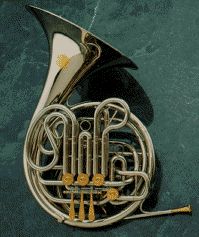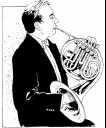| ||||||||
The French Horn

The french horn's early history was in the form of animal horns or tusks. Ancestors include the medieval hunting horn, royal African ivory horns, the Roman cornu and the Jewish shofar. However, the orchestral horn was derived from the trompe de chasse, a large hunting horn that appeared in France in 1650. It is a large version of the smaller crescent-shaped horns, redesigned with circularly coiled tubing.
The orchestral use of the horn began at about 1700 when the Trompe de Chasse was introduced from France into Bohemia. It produced about twelve tones of the natural harmonic series. In 1750, the horn gained greater flexibility with the invention of the "hand stopping" technique. It involves placing a hand in the bell of the horn to alter the pitch of the natural notes by as much as a tone, hence the name "hand horn." However, to play pieces in many keys, cumbersome lengths of tubings called crooks were used. The invention of valves in the 19th century allowed the player to alter the length of the tubing by the motion of a finger. With this new technology, the horn could produce a chromatic scale of over three octaves. The modern horn has three valves, circular coils of narrow tubing flaring at one end to a wide bell. Its funnel-shaped mouthpiece accounts for its mellow tone which classical composers find so useful. Modern orchestras use four horns, usually double horns in F and B-flat which is equipped with an extra valve to switch to the B-flat tubing. This offers certain technical advantages, such as easier playing higher octaves.
Famous horn players include Barry Tuckwell, Hermann Baumann, Micheal Thompson and Dennis Brain. The latter was probably the greatest of them all. As a student at the Royal Academy of Music, Dennis would play "The Flight of the Bumble Bee" with such ease that he was the envy of his fellow musicians. He was such a virtuoso that both the Philharmonia and the Royal Philharmonic Orchestras competed for his presence. Hindermith was so impressed by Brain's interpretation of his horn concerto that he inscribed on Brain's score "to the unsurpassable original performer of this work from a grateful composer." He had such control that at the Royal Albert Hall, he played the Leopold Mozart Alpine Horn Concerto on a length of green garden hose fitted with a mouthpiece. However, Brain's sparkling career was tragically cut short at 36 years old, when he met with a car accident. Such admiration was commanded by Brain that his horn, crumpled like a newspaper in the accident, was restored after months of work by London horn makers, Paxman. The french horn was selected by The Guinness Book of Records as one of the two most difficult instruments to play, the other being the oboe. The amount of technique and practice needed can't be overestimated. One possible reason could be that the harmonics are so close together that it is easy to mispitch or go out of tune. It is tiring on the lungs too: you'll occasionally see three horn players in an orchestra playing two parts, with one player, called a "bumper," taking the simpler lines after a soloist has played their obligato so that they can get their breath back. Another interesting fact is that psychologists have proven that horn players are usually quiet and anti-social. I think it is because countless hours need to be spent alone in order to master this instrument. Music for the solo horn took off in the 1700s to the extent that concertos began to appear. Vivaldi wrote two for two horns, Mozart wrote the four famous horn concertos which have an interesting story behind it. Mozart wrote these concertos for his Salzburg friend Ignaz Leutgeb who was the butt of endless jokes by the composer. Arriving on stage, Leutgeb would find that his manuscripts in a haphazard order or that the notes were in different colours. Nevertheless, the horn concertos were masterpieces and essential repertoire to any horn player. Another famous Horn solo is Tchaikovsky's Symphony No. 5 in E Minor.
Paul is a music lover from Singapore. His interests include classical music, musical instruments (especially the French horn) and HTML. He maintains both the French Horn Resource Page and the French Hornist Webring.
|
|




